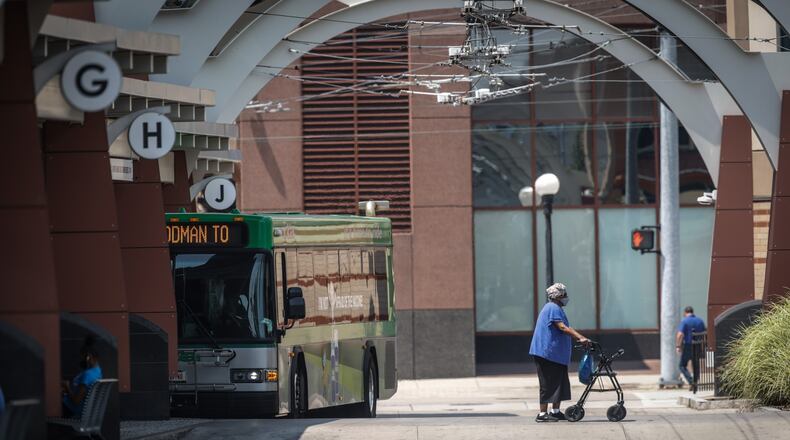Most RTA riders have started using the new Tapp Pay fare system, but about one in 10 still pay with cash and some say they don’t feel comfortable using reloadable cards to pay for their trips, according to RTA staff and a rider survey.
The RTA is spreading the word about its cashless vehicles through customer outreach, social media posts, new signage, informational materials and educational videos on its website, said Brandon Policicchio, the Greater Dayton RTA’s chief customer and business development officer.
The switch originally was supposed to happen in June, but it was pushed back about five months to give people more time to adjust.
“We wanted to provide more time for our customers to transition over to the new system and utilize any existing fares they may have had from the previous system,” Policicchio said.
Some RTA riders told this newspaper the new system is easy to use and convenient.
Joshua Kirkpatrick, 41, of East Dayton, said he didn’t know at first how to use the Tapp Pay system, but he figured it out quickly.
Kirkpatrick, who rides the bus every couple of days to shop and for appointments, said it shouldn’t be hard for other bus riders to adjust.
“I think everybody will catch onto it,” he said, adding that the most important thing is for the RTA to spread the word about the switch.
The Greater Dayton RTA will stop accepting cash fares on board its vehicles Nov. 1.
The agency originally planned for its fleet of vehicles to go fully cashless in June but it decided to delay the implementation date after hearing feedback from community members, stakeholders and staff.
RTA’s vehicles no longer will accept hard cash, but physical currency will still be accepted at the RTA’s downtown payment kiosks and at more than 200 “cash conversion” outlets across the region.
The RTA launched its Tapp Pay system in June 2020, which lets customers pay for rides either by downloading the Transit app or by acquiring reloadable smartcards.
The cards are only available at RTA’s five transit centers and can be loaded at their kiosks.
Customers also can reload their cards at about 202 retail locations that are within one-quarter mile of RTA’s fixed bus routes, the agency said.
Customers can use cash at retail locations, debit and credit cards at RTA kiosks and the downtown transit kiosk also accepts cash.
RTA’s longtime fare system accepted cash and paper tickets.
A survey conducted in 2020 and 2021 found that more than 40% of RTA riders used Tapp Pay to pay for their trips while less than 20% paid with cash. Other riders paid with day, weekly or monthly passes.
But Policicchio said currently about 85% of RTA customers are on Tapp Pay, while 10% use cash and about 5% are using old passes.
The RTA stopped selling on-board day passes on June 30, and the overwhelming majority of people switched over to the electronic payment system, the agency said.
Old system paper passes ceased being sold in April, and all old system passes must be used by Sept. 1.
Policicchio said equity is the largest benefit of the cashless system because customers can hold onto their money longer and save money as well.
“Traditional transit payment systems create a situation where those least able to afford the upfront costs of monthly passes end up spending the most by the end of the month, by utilizing cash every day for single rides or day passes,” he said.
The cashless on-board system means the agency caps customer fares, ensuring they never pay more than the daily or monthly (rolling 31-day) max fare, he said.
Many customers pay $2 every in cash every time they board, he said, but with Tapp Pay, the most they will ever spend in a day for unlimited travel is $3.
Tapp Pay also will lead to quicker customer boardings and fewer mechanical or other issues with fare machines, he said.
The vast majority of riders said they would be comfortable using a RTA reloadable fare card to pay for their trips, but about 13% said they wouldn’t be, according to the rider survey.
The survey also found that about 92% of riders did not have a vehicle available to make their trips, and most riders (more than six in 10) ride the bus every day.
Nearly 84% of riders have a household income below $25,000, while nearly 95% have incomes below $35,000.
“This shows just how vital RTA services are to many in the community, and that without our services they would not be able to get to jobs or critical medical appointments,” Policicchio said.
About 23% of riders do not have a checking or savings account, while nearly 18% do not own a smartphone.
The RTA plans to continue offering reduced promotional costs for daily and monthly fare cap rates for Tapp Pay.
The RTA also offers promotional credits for users who create new Tapp Pay accounts in the system, and the agency is exchanging paper fare passes with Tapp Pay.
Greater Dayton RTA operates 300 fixed route and paratransit vehicles. The agency handles more than 9 million passenger trips each year, and it has about 3,000 stops and more than two dozen routes in the region.
About the Author


